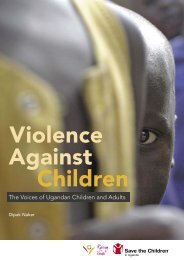CA C 1 - Raising Voices
CA C 1 - Raising Voices
CA C 1 - Raising Voices
You also want an ePaper? Increase the reach of your titles
YUMPU automatically turns print PDFs into web optimized ePapers that Google loves.
conventions info sheet<br />
254<br />
Women’s Right’s and the Conventions that Protect Them<br />
Mobilising Communities to Prevent Domestic Violence<br />
conventions info sheet<br />
What are Rights?<br />
All human beings have rights. They are inalienable – which means they cannot be taken from you by<br />
anyone, including the government, law enforcement officials, doctors, religious leaders, your boss,<br />
members of your family, or your spouse.<br />
Do women and men have different rights?<br />
All human beings, women and men, have the same rights and freedoms. Some rights are specifically<br />
related to women, (e.g., rights related to sexual violence, pregnancy, and childbearing).<br />
Do women and men have different responsibilities?<br />
All human beings have the responsibility to protect and ensure the rights of others. No one, woman or<br />
man, has the right to deny or violate another person’s rights.<br />
Who has the responsibility to protect our rights?<br />
International conventions hold governments accountable for protecting the rights of their citizens.<br />
However, all of us have a responsibility to respect and protect the human rights of others.<br />
Why are there international documents on human rights?<br />
After the terrible human rights abuses that happened during World War II, the Human Rights<br />
Commission of the United Nations (UN) drafted a Universal Declaration of Human Rights (UDHR).<br />
People from around the world contributed their ideas and beliefs to this document. The General<br />
Assembly of the UN adopted the UDHR in 1948. It describes the inalienable rights of all members of<br />
the human family. Since then, many more conventions have been written that describe human rights<br />
and the rights of particularly vulnerable groups, such as women.<br />
What is a convention?<br />
A convention is a document that defines human rights. It is a legally binding international agreement<br />
between countries. When a country ratifies a convention, it means that they agree to ensure that the<br />
rights described in the convention are enjoyed by all people in their country or jurisdiction.<br />
What is the difference between a convention and a declaration?<br />
Conventions are a part of international law and are legally binding to state parties. Declarations are<br />
non-binding but carry significant moral commitment and responsibility in the international community.<br />
Which conventions relate to women?<br />
The International Bill of Human Rights includes: the Universal Declaration of Human Rights (UDHR), the<br />
International Covenant on Civil and Political Rights (ICCPR), the International Covenant on Economic,<br />
Social, and Cultural Rights (ICESCR). The African (Banjul) Charter on Human and People’s Rights is the<br />
regional human rights convention that binds members of the African Union. All of the articles in these<br />
documents apply equally to women and men.<br />
The Convention on the Elimination of All forms of Discriminations Against Women (CEDAW) offers the<br />
most comprehensive coverage of women’s rights for both public and private spheres. The other<br />
documents that are important for women are The Vienna Declaration and Programme of Action,<br />
Beijing’s Platform for Action and Declaration on the Elimination of Violence Against Women (DEVAW).<br />
DEVAW is the most comprehensive document on violence against women.

















